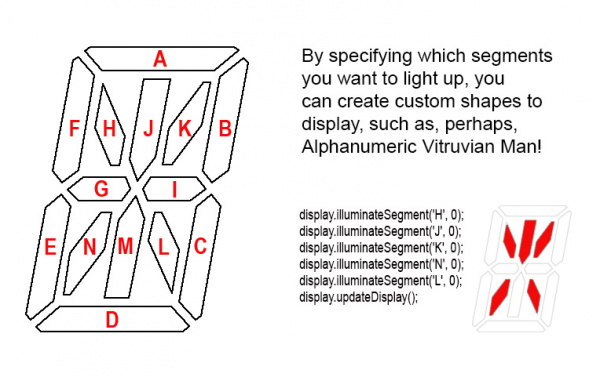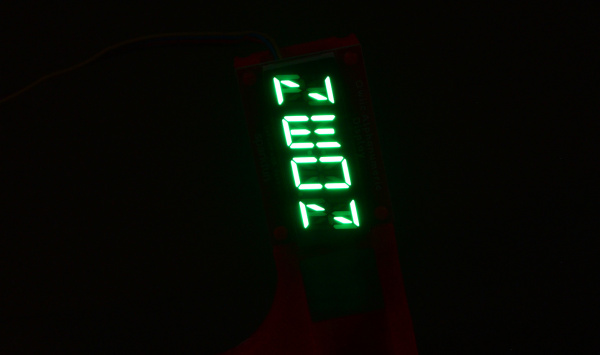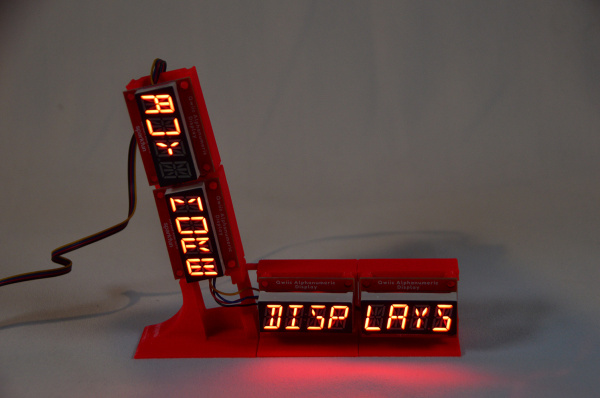Moving Beyond the Ordinary With the Qwiic Alphanumeric Display
Going beyond the Expected
Sometimes it’s fun to take something, completely ignore its intended use, and turn it on its head. Or at least, on its side. I found myself wondering if I could use these Alphanumeric Modules for Vertical display. Of course, if we had single character boards, it would be simple. But with four characters per board, stacking vertically becomes a bit more of a challenge. Luckily, as we learned in Example 02 Turn On One Segment, we can control each of the fourteen segments of each character individually. What that example doesn’t show is that we can turn on multiple segments at once, allowing us to create any number of shapes. In its simplest form, you can think of the segments that make up the letter “U”. If you turn the display on its end, those same segments will give you a low, wide, letter “C”.
The code below will give you an idea of what it takes to create vertical displays.
/*******************************************************************************************
* This example tests illuminating individual segments to create a vertical display of sorts.
* We will also use characters that, when turned on their side, can pass for vertical displays.
* ex using a Z as an N
*
* Pass in the segment
* and digit you wish to illuminate to illuminateSegement().
*
*
*
* SparkFun labored with love to create this code. Feel like supporting open source hardware?
* Buy a board from SparkFun! https://www.sparkfun.com/products/16391
*
* This code is Beerware; if you see me (or any other SparkFun employee) at the
* local, and you've found our code helpful, please buy us a round!
*
* Hardware Connections:
* Attach Red Board to computer using micro-B USB cable.
* Attach Qwiic Alphanumeric board to Red Board using Qwiic cable.
*
* Distributed as-is; no warranty is given.
*****************************************************************************************/
#include <Wire.h>
#include <SparkFun_Alphanumeric_Display.h> //Click here to get the library: http://librarymanager/All#SparkFun_Qwiic_Alphanumeric_Display by SparkFun
HT16K33 display;
void setup()
{
Serial.begin(115200);
Serial.println("SparkFun Qwiic Alphanumeric - Example 2: Turn On One Segment");
Wire.begin(); //Join I2C bus
//check if display will acknowledge
if (display.begin() == false)
{
Serial.println("Device did not acknowledge! Freezing.");
while(1);
}
Serial.println("Display acknowledged.");
display.clear();
delay(1000);
}
void loop()
{
//code();
//delay(5000);
//name();
//delay(5000);
neon();
delay(5000);
//zone();
//delay(5000);
}
void code()
{
display.clear();
display.printChar('U', 0); // Flip it sideways, it becomes a C
display.printChar('O', 1); // Sometimes an O is just an O
// On the next six lines, we illuminate specific segments to create a very wide D
display.illuminateSegment('A', 2);
display.illuminateSegment('B', 2);
display.illuminateSegment('C', 2);
display.illuminateSegment('E', 2);
display.illuminateSegment('F', 2);
display.illuminateSegment('G', 2);
display.illuminateSegment('I', 2);
// Thus endeth the creation of the sideways D
// On the next six lines, we illuminate specific segments to create a very wide E
display.illuminateSegment('B', 3);
display.illuminateSegment('C', 3);
display.illuminateSegment('D', 3);
display.illuminateSegment('E', 3);
display.illuminateSegment('F', 3);
display.illuminateSegment('J', 3);
display.illuminateSegment('M', 3);
// Thus endeth the creation of the sideways E
display.updateDisplay();
delay(100);
}
void name()
{
display.clear();
display.printChar('Z', 0); // Flip it sideways, it becomes an N
// On the next six lines, we illuminate specific segments to create a very wide A
display.illuminateSegment('A', 1);
display.illuminateSegment('D', 1);
display.illuminateSegment('E', 1);
display.illuminateSegment('F', 1);
display.illuminateSegment('J', 1);
display.illuminateSegment('M', 1);
// Thus endeth the creation of the sideways A
// We will now attempt to make a sideways M
display.illuminateSegment('A', 2);
display.illuminateSegment('D', 2);
display.illuminateSegment('N', 2);
display.illuminateSegment('H', 2);
// Thus endeth the creation of the sideways M
// On the next six lines, we illuminate specific segments to create a very wide E
display.illuminateSegment('B', 3);
display.illuminateSegment('C', 3);
display.illuminateSegment('D', 3);
display.illuminateSegment('E', 3);
display.illuminateSegment('F', 3);
display.illuminateSegment('J', 3);
display.illuminateSegment('M', 3);
// Thus endeth the creation of the sideways E
display.updateDisplay();
delay(100);
}
void neon()
{
display.clear();
display.printChar('Z', 0); // Flip it sideways, it becomes an N
// On the next six lines, we illuminate specific segments to create a very wide E
display.illuminateSegment('B', 1);
display.illuminateSegment('C', 1);
display.illuminateSegment('D', 1);
display.illuminateSegment('E', 1);
display.illuminateSegment('F', 1);
display.illuminateSegment('J', 1);
display.illuminateSegment('M', 1);
// Thus endeth the creation of the sideways E
display.printChar('O', 2); // Sometimes an O is just an O
display.printChar('Z', 3); // Flip it sideways, it becomes an N
display.updateDisplay();
delay(100);
}
void zone()
{
display.clear();
// We will now attempt to make a sideways Z
display.illuminateSegment('E', 0);
display.illuminateSegment('F', 0);
display.illuminateSegment('H', 0);
display.illuminateSegment('L', 0);
display.illuminateSegment('C', 0);
display.illuminateSegment('B', 0);
// Thus endeth the creation of the sideways Z
display.printChar('O', 1); // Sometimes an O is just an O
display.printChar('Z', 2); // Flip it sideways, it becomes an N
// On the next six lines, we illuminate specific segments to create a very wide E
display.illuminateSegment('B', 3);
display.illuminateSegment('C', 3);
display.illuminateSegment('D', 3);
display.illuminateSegment('E', 3);
display.illuminateSegment('F', 3);
display.illuminateSegment('J', 3);
display.illuminateSegment('M', 3);
// Thus endeth the creation of the sideways E
display.updateDisplay();
delay(100);
delay(25000);
}
And if you want to get really crazy, you can combine vertical and horizontal! Combining the display.illuminateSegment() calls with the display.printChar() calls (and making sure you assign each to their proper character number) will put you high and above all others with their simple horizontal alphanumeric displays.
/**************************************************************************************
* This example allows for both vertical and horizontal display of characters.
* Keep in mind that they are not designed for vertical use, so some of the characters
* are a little off. Hey, it's the best I could do!
*
* Rob Reynolds @ SparkFun Electronics
* Original Creation Date: November 11, 2024
*
* SparkFun labored with love to create this code. Feel like supporting open source hardware?
* Buy a board from SparkFun! https://www.sparkfun.com/products/19297
*
* This code is Beerware; if you see me (or any other SparkFun employee) at the
* local, and you've found our code helpful, please buy us a round!
*
* Hardware Connections:
* Attach Red Board to computer using micro-B USB cable.
* Attach Qwiic Alphanumeric board to Red Board using Qwiic cable.
* Don't close any of the address jumpers so that it defaults to address 0x70.
* Attach a second Alphanumeric display using Qwiic cable.
* Close address jumper A0 so that this display's address become 0x71.
* Close the necessary jumpers (A0 and/or A1) to change the other displays I2C
* addresses to 0x72 znd 0x73. See hoolup guide or tutorial for specifics.
*
* Distributed as-is; no warranty is given.
*****************************************************************************************/
#include <Wire.h>
#include <SparkFun_Alphanumeric_Display.h> //Click here to get the library: http://librarymanager/All#SparkFun_Qwiic_Alphanumeric_Display by SparkFun
HT16K33 display;
void setup() {
Serial.begin(115200);
Serial.println("SparkFun Qwiic Alphanumeric - Example 8: Multi Display");
Wire.begin(); //Join I2C bus
//check if displays will acknowledge
//The first address in the begin() function should be the left-most display, traveling to the right from there
//This is how the string will print across displays, reading from left to right.
if (display.begin(0x70, 0x71, 0x72, 0x73) == false)
{
Serial.println("Device did not acknowledge! Freezing.");
while(1);
}
Serial.println("Displays acknowledged.");
display.setBrightness(15);
display.clear();
//display.print("*BUY MOREDISPLAYS");
}
void loop()
{
//display.printChar('*', 0); // An asterisk is an asterisk from any angle!
// We can make an arrow pointing in any direction. I'll go with Down
//display.illuminateSegment('G', 0);
//display.illuminateSegment('H', 0);
//display.illuminateSegment('N', 0);
// Thus endeth the creationNof the sideways Down Arrow
// We will now attempt to make a sideways B
display.illuminateSegment('A', 0);
display.illuminateSegment('B', 0);
display.illuminateSegment('C', 0);
display.illuminateSegment('E', 0);
display.illuminateSegment('F', 0);
display.illuminateSegment('G', 0);
display.illuminateSegment('I', 0);
display.illuminateSegment('J', 0);
// Thus endeth the creation of the sideways B
// Here is how we make a sideways U
display.illuminateSegment('A', 1);
display.illuminateSegment('B', 1);
display.illuminateSegment('C', 1);
display.illuminateSegment('D', 1);
// Thus endeth the sideways U
// This will hopefully look like a sideways Y
display.illuminateSegment('H', 2);
display.illuminateSegment('I', 2);
display.illuminateSegment('N', 2);
// Thus endeth the sideways Y
// We will now attempt to make a sideways M
display.illuminateSegment('A', 4);
display.illuminateSegment('D', 4);
display.illuminateSegment('N', 4);
display.illuminateSegment('H', 4);
// Thus endeth the creation of the sideways M
display.printChar('O', 5); // Sometimes an O is just an O
// We will now attempt to make a sideways R
display.illuminateSegment('D', 6);
display.illuminateSegment('E', 6);
display.illuminateSegment('F', 6);
display.illuminateSegment('H', 6);
display.illuminateSegment('K', 6);
display.illuminateSegment('M', 6);
// Thus endeth the creation of the sideways R
// On the next six lines, we illuminate specific segments to create a very wide E
display.illuminateSegment('B', 7);
display.illuminateSegment('C', 7);
display.illuminateSegment('D', 7);
display.illuminateSegment('E', 7);
display.illuminateSegment('F', 7);
display.illuminateSegment('J', 7);
display.illuminateSegment('M', 7);
// Thus endeth the creation of the sideways E
display.printChar('D', 8);
display.printChar('I', 9);
display.printChar('S', 10);
display.printChar('P', 11);
display.printChar('L', 12);
display.printChar('A', 13);
display.printChar('Y', 14);
display.printChar('S', 15);
display.updateDisplay();
//display.print("*BUYMOREDISPLAYS");
//delay(1000);
//display.clear();
//delay(250);
//display.print("*BUYMORESPARKFUN");
//delay(1000);
//display.clear();
delay(25000);
}


